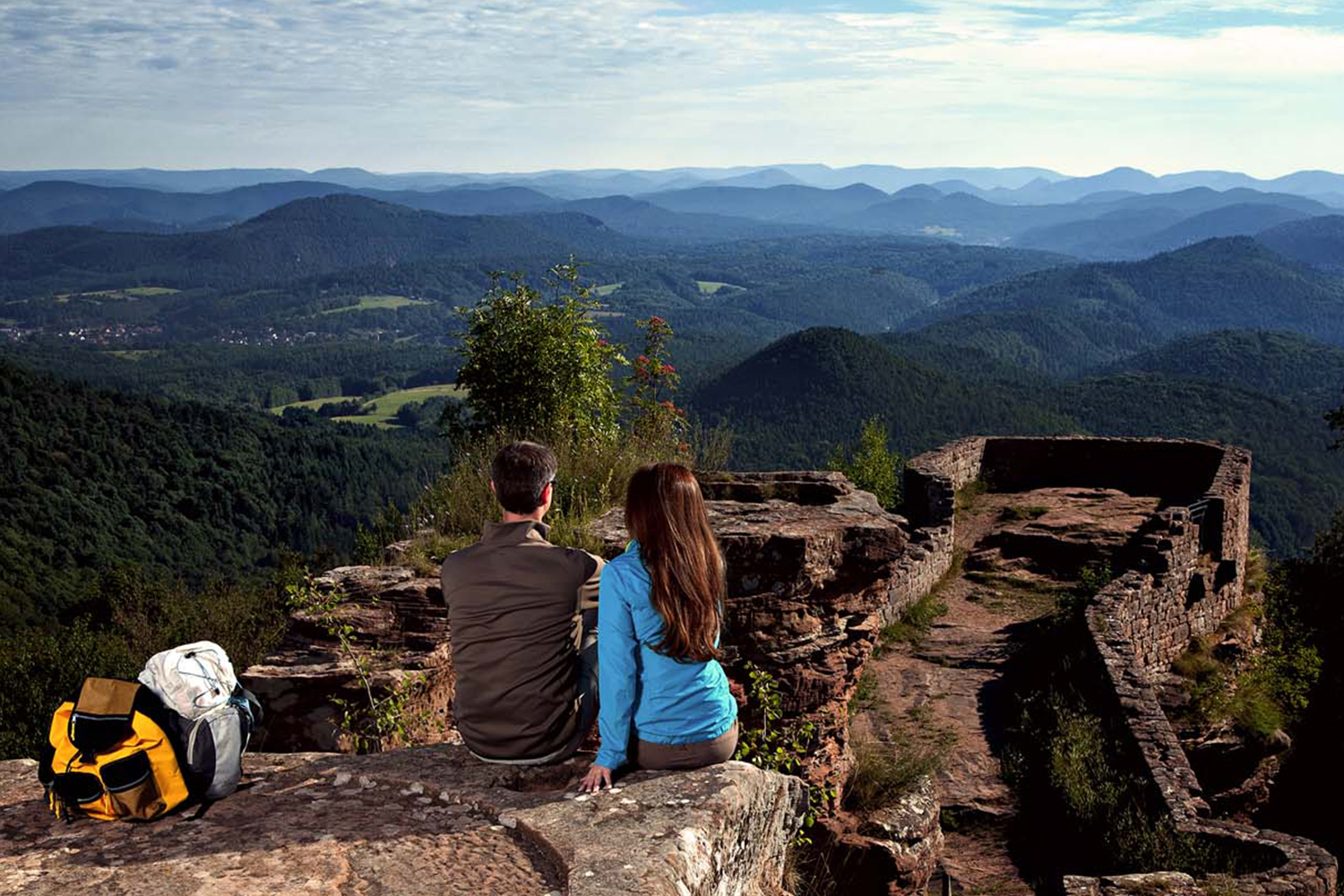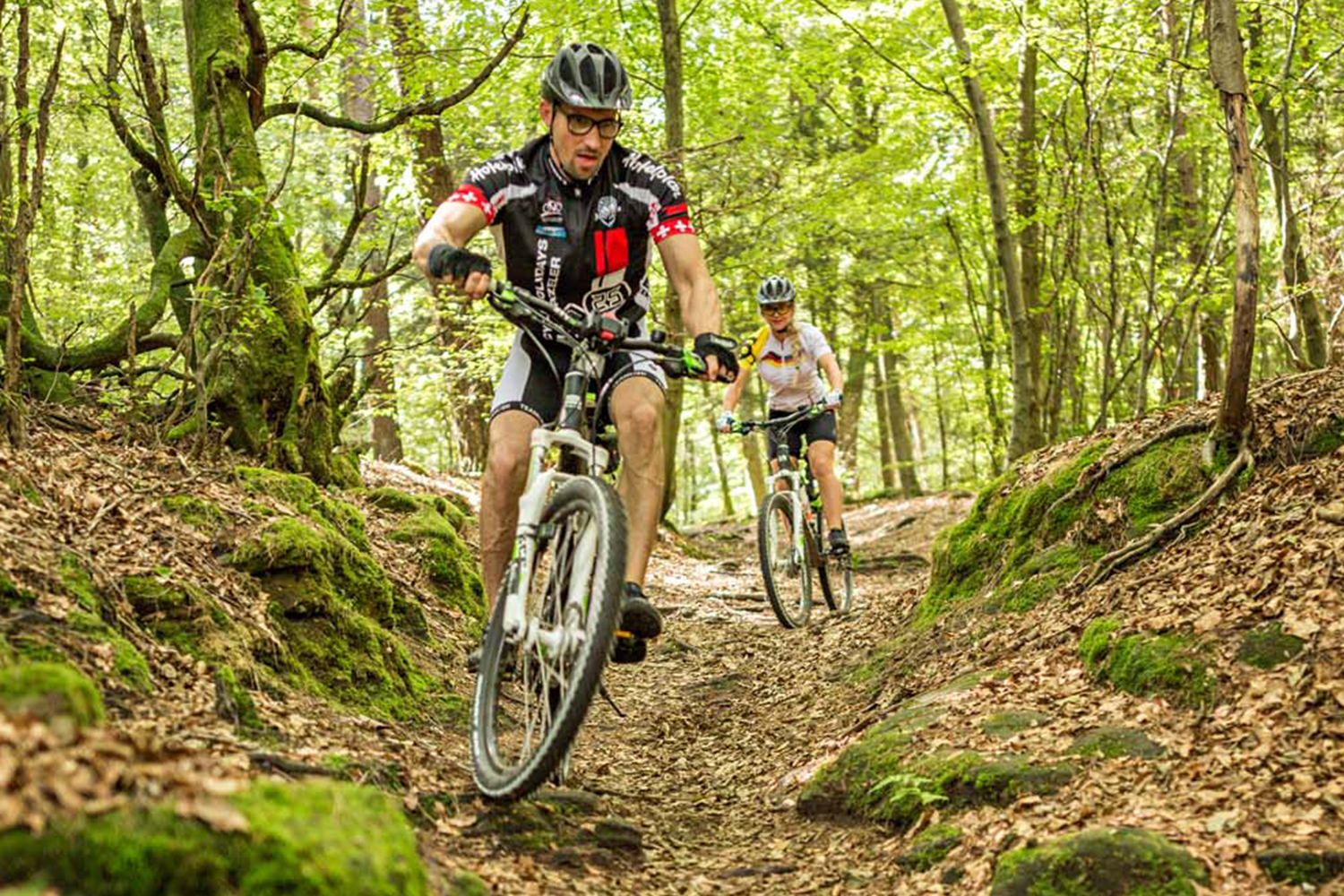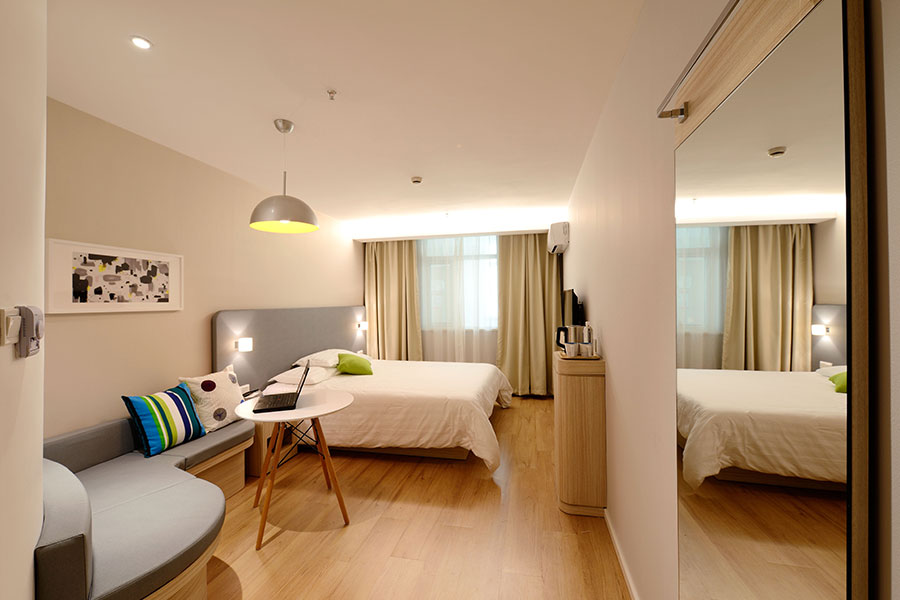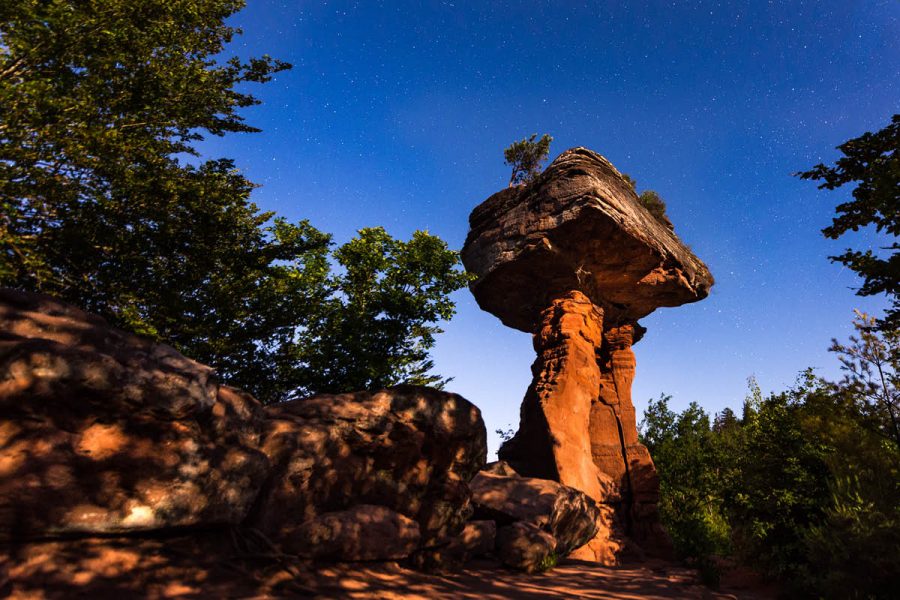THE LANDSCAPES OF THE WEST PALATINATE
The Palatinate Forest – much more than just trees
Nothing dominates the West Palatinate landscape like the Palatinate Forest. Germany’s largest contiguous forest area, which together with the French Northern Vosges is under special protection as a cross-border UNESCO biosphere reserve, can look back on an eventful past. Numerous castle ruinsand knight stones of the Palatinate Forest Association, which refer to historically significant places and events. Fountains or man-made water bodiessuch as woogs and drifting streams also bear witness to the rich cultural history of the Palatinate Forest.
Today it is one of Germany’s largest protected areas and a paradise for flora and fauna – in recent years it has even managed to reintroduce the formerly native lynx. But it is also a place of longing for many of us. Whether for climbing or photography, whether for picking mushrooms or looking at stars – each of us uses the Palatinate Forest in his or her own personal way. And if you take a closer look here, it quickly becomes clear: not all Palatinate forests are the same. The low mountain range, which adjoins the French Vosges on the German side, has different faces.
Wasgau and Dahner rock land
Crossing the French border, the seamless transition of the Northern Vosges into the Southern Palatinate Forest becomes apparent both in terms of landscape and name: The landscape is called Wasgau and has its linguistic origin – just like the Vosges – in the Celtic mountain and forest god Vosegus. This was later adopted by the Romans to designate the forests. Due to the small-scale relief, the Wasgau with its richly forested cone mountains and ridges is characterized by a great variety of forms. The red red sandstone is characteristic: it originates from a time when desert climate prevailed and was shaped by wind and weather into bizarre rock formations.
Mighty castles were built on many rocks in the Middle Ages – today, most of them are mystical ruins that, from a distance, can hardly be distinguished from the naturally formed rock towers and yet exude a very special atmosphere. Especially around the town of Dahn, the rock formations are ubiquitous – the Dahner Felsenland is now a climber’s paradise and has been named one of seven German premium hiking regions.
For photography enthusiasts, the region is highly rated. Especially in autumn, a climb up the rocks is worthwhile; not infrequently, a chain of hills peeks out of an extensive sea of fog. Towards the east, the landscape is increasingly broken up by meadow valleys – here, numerous photo spots around Hauenstein, for example the Rauhfels, the Rötzenfels, the Dickenbergturm (Sprinzelfels) or the Geiersteine with great panoramas, tempt visitors.

An impressive panorama over the entire Palatinate Forest offers the Luitpold towernear Merzalben. (Photo: Harald Kröher)
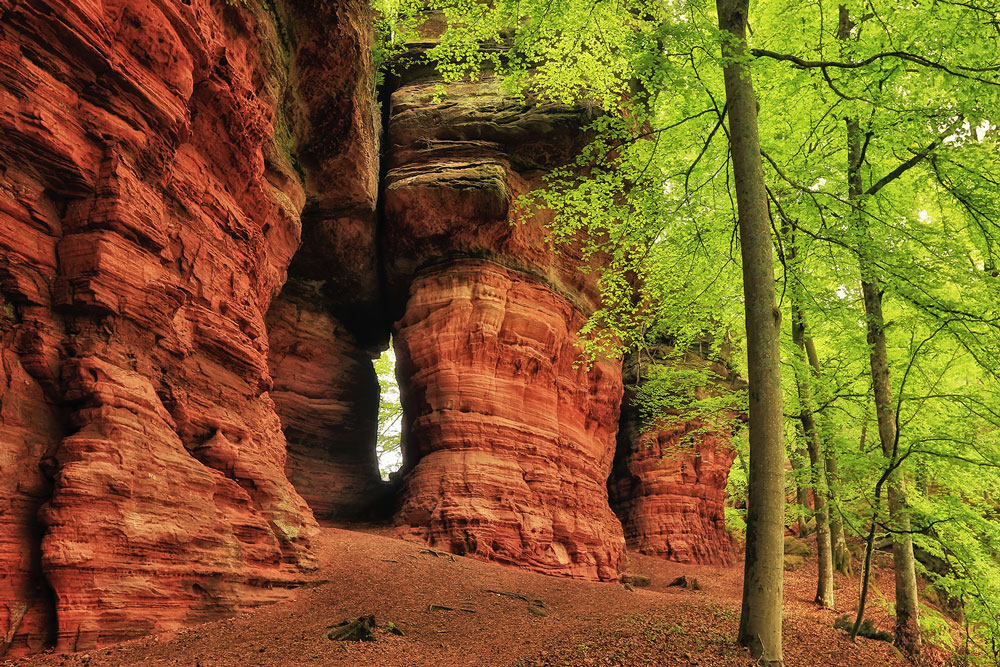
The Altschlossfelsen near Eppenbrunn is the largest rock formation in the Palatinate. (Photo: Harald Kröher)

Mystic castle ruins characterize the Palatinate Forest, here the Wegelnburg Castle near Nothweiler on the border with France (Photo: Harald Kröher).
Gräfensteiner Land and Palatinate Woodland
On the southwestern edge of the Palatinate Forest lies the town of Pirmasens, which rose to become a shoe metropolis during industrialization. One of the former shoe factories now houses the hands-on technology museum Dynamikum Science Center. The forest area near Pirmasens and Rodalben is called Gräfensteiner Land. Particularly popular destinations there are the namesake Castle Gräfenstein and the Luitpold Tower, which offers a breathtaking 360-degree view of the Palatinate Forest and beyond.
Further north, between Moosalb and Schwarzbach, is the Palatinate timberland, which got its name from the outstanding quality of its forest stands. The highest prices are achieved by the sessile oaks, often several hundred years old, which have even survived the times of greatest depletion by forest grazing, charcoal burning and mining. Their wood is often used for wine barrels, which not infrequently make it as far as Bordeaux, where they are used to age the noblest drops.
Historically significant is also the place of pilgrimage Maria Rosenberg in Waldfischbach-Burgalben. The Celts are said to have consecrated the spring there (Gnadenbrunnen) to the god of thunderstorms before the first Christian chapel was built in 1150.
Frankenweide
The central part of the Palatinate Forest is called Frankenweide. As the term suggests, the name originated as early as Frankish times in the 6th century – even though the area was largely uninhabited at the time and was used only as cattle pasture. This is a high plateau landscape bordered by deeply cut valleys. For example, the wildly romantic Karlstal near Trippstadt, one of the most beautiful valleys in the Palatinate Forest, where the beginnings of the iron industry along the Moosalb have left exciting traces in past centuries.
The historic site of Johanniskreuz is also not far from here: Across from the spot where two knights from the region once argued over road toll and backed up their claim by erecting stone crosses, today stands the House of Sustainability, an information and experience center dedicated to the topics of forests, the environment and nature. At the same time, the Palatinate’s main watershed is located here: the springs to the east flow to the Rhine, while those to the west flow to the Moselle. Leaving the West Palatinate from here in an easterly direction, one enters the Elmstein Valley, which is best known as the destination of the historic Kuckucksbähnel excursion railroad.
Finally, to the northwest, the Palatinate Forest is bordered by the Kaiserslauter Valley and the Landstuhler Bruch. Kaiserslautern, known for Emperor Frederick Barbarossa and the Red Devils of the Betzenberg, is the only major city that lies partially within the Pfälzerwald Biosphere Reserve. As Silicon Wood, Kaiserslautern has recently made a name for itself as a renowned location around IT technology.
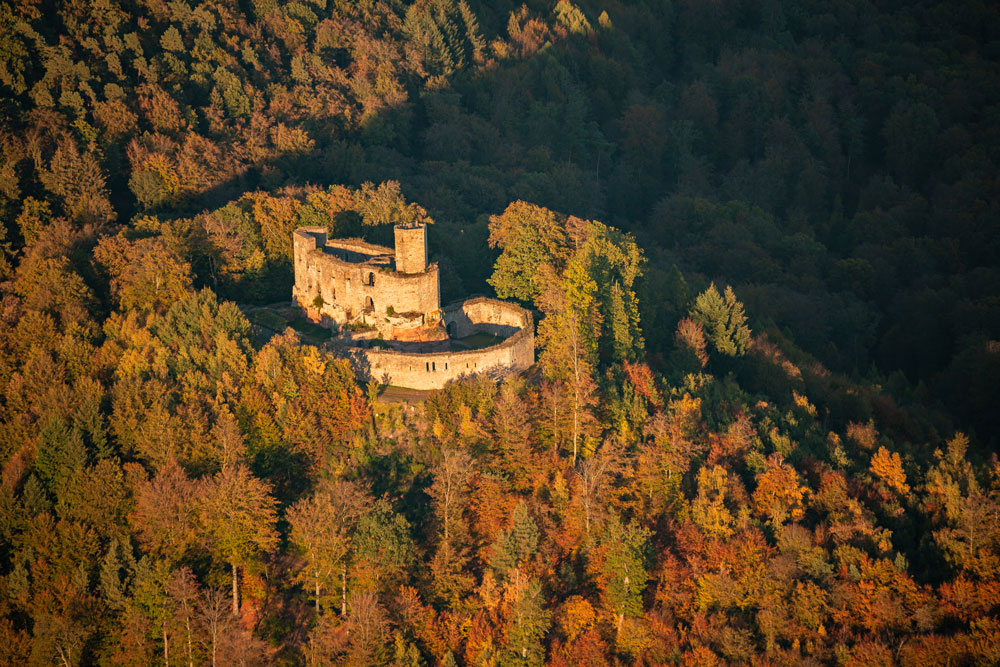
The Castle Ruin Gräfenstein dates from the 12th century, is well preserved and is considered one of the most important Staufer-period castle complexes in Rhineland-Palatinate. (Photo: Harald Kröher)
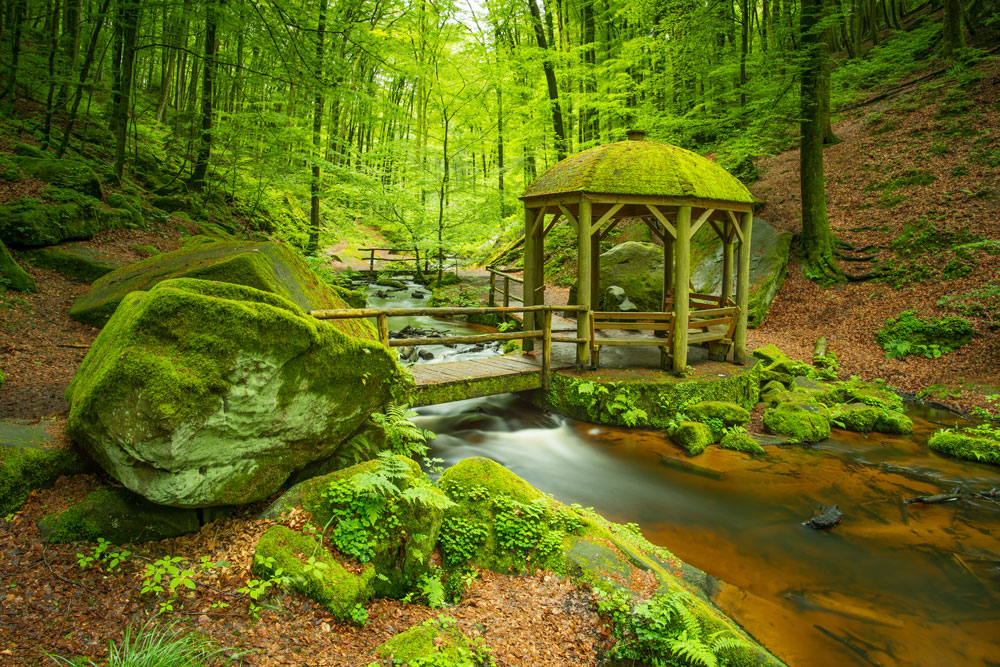
The Karlstal Gorge near Trippstadt, designed by the famous landscape architect Friedrich Ludwig von Sckell, is considered one of the most beautiful valleys in the Palatinate Forest. (Photo: Anna Wojtas)

On the northwestern edge of the Palatinate Forest lies the university town of Kaiserslautern. (Photo: Andreas Gläser)
Diemerstein Forest and Stumpfwald
Further east – between Hochspeyer, Enkenbach-Alsenborn, Carlsberg and Frankenstein – the Palatinate Forest continues to the north, this area is called Diemerstein Forest. The name comes from the fact that the lords of the Castle Diemerstein were once also owners of this forest. Below the castle, first mentioned in 1216, there is also Villa Denis, named after the railroad pioneer Paul Camille von Denis. As the endowment house of the Technical University of Kaiserslautern, it is the destination of the annual University Villa Hike and regularly attracts visitors through an attached café.
Even further north is the Stumpfwald forest, whose foothills are clearly visible from the Donnersberg, the highest mountain in the Palatinate. The Stumpfwald is best known for the Eiswoog reservoir near Ramsen and the historic Stumpfwald Railway with several viaducts. The Stumpfwaldgericht, an old German assembly and court site, is still well preserved. Since the Middle Ages, light to serious offenses and even crimes worthy of death were judged here. The fabled Stumpfwald Cave, in turn, is said to have housed a regionally renowned wrongdoer.
Beyond West Palatinate: Haardt and Weinstraße
A well-known sub-mountain range of the Palatinate Forest, although not located in the West Palatinate, is the Haardt. There are the highest peaks of the Palatinate Forest, before the landscape drops steeply to the east and merges with the Upper Rhine lowlands. On this border lies the well-known German Wine Route [Deutsche Weinstraße], a popular destination for many people in the West Palatinate when Mediterranean flair or simply a little variety is called for.
Speaking of variety: if the sheer diversity of the forest, the rugged cliffs and legendary castles are not enough, the West Palatinate offers other exciting cultural landscapes – from the rolling hills of the Nordpfälzer Bergland to the wine-growing landscape of the Zellertal. Boredom is definitely not an option in the West Palatinate…
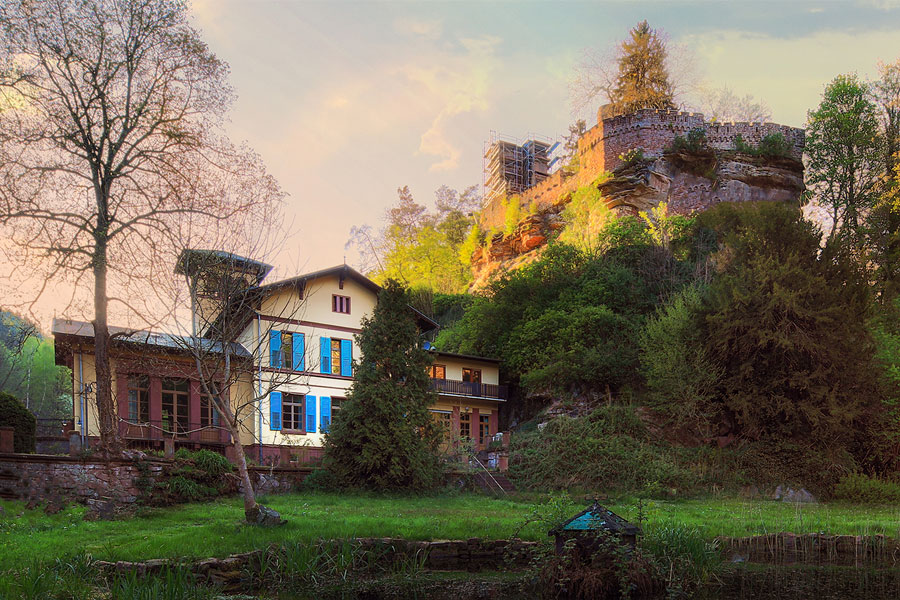
Beautifully situated in the Diemerstein valley: Villa Denis and Diemerstein Castle. (Photo: Harald Kröher)
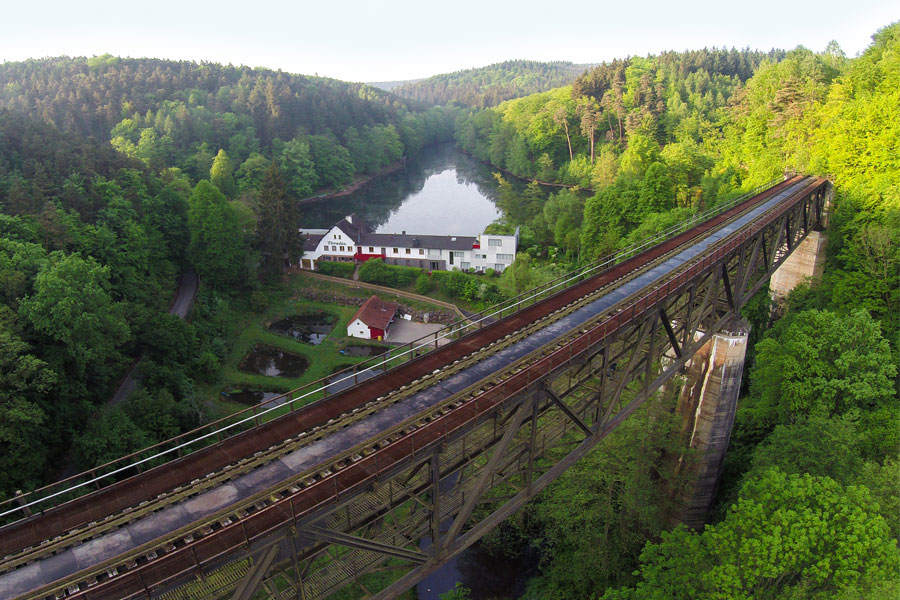
Just north of the Eiswoog, the 35-meter-high Eistal Viaduct spans the Eisbach Valley. (Photo: Anna Wojtas)
